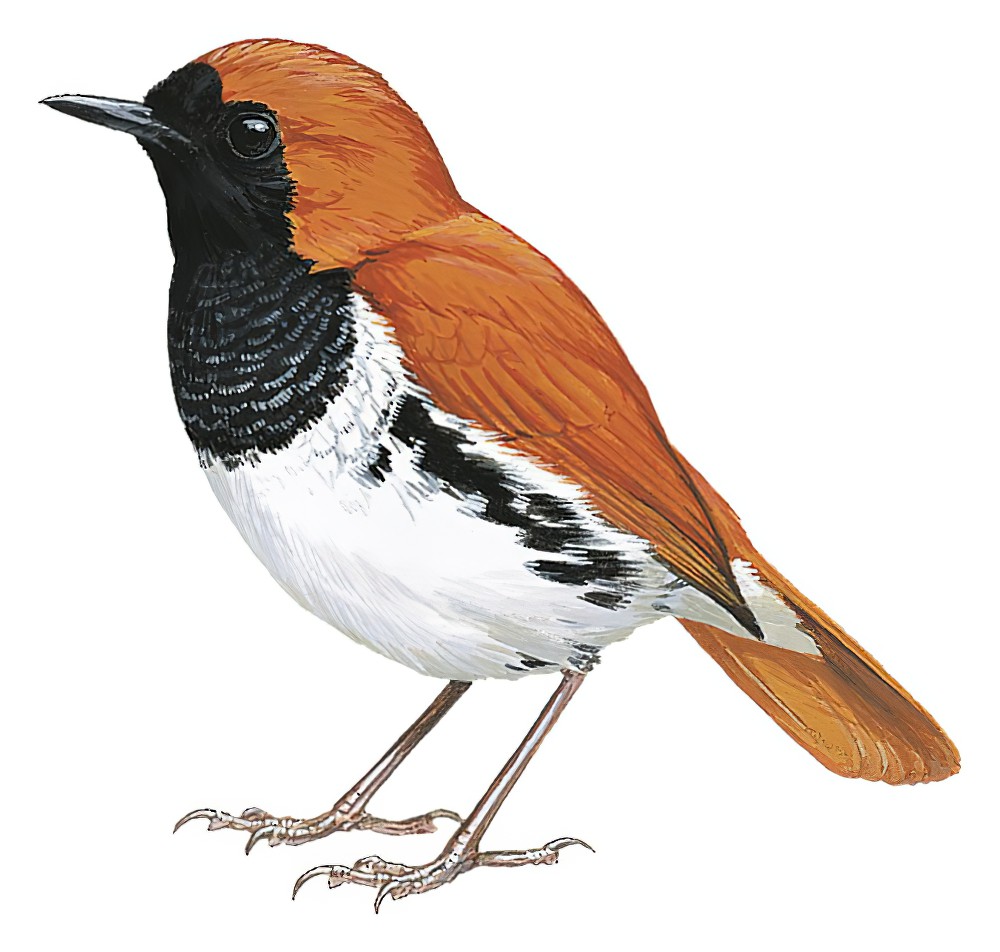Ryukyu Robin / Larvivora komadori

Ryukyu Robin
SCI Name:
Protonym: Sylvia komadori Pl.Col. livr.96 pl.570
Taxonomy: Passeriformes / Muscicapidae / Larvivora
Taxonomy Code: ryurob1
Type Locality: Korea ; corrected to northern Riu Kius and Tanegashima by Kuroda, 1923, op. cit., p. 106.
Author: Temminck
Publish Year: 1835
IUCN Status:
DEFINITIONS
LARVIVORA
(Muscicapidae; Ϯ Siberian Blue Robin L. cyane) Mod. L. larva caterpillar, larvae < L. larva spectre, mask; L. -vorus -eating < vorare to devour; "CRATEROPODINÆ. Genus Larvivora, nobis. Bill equal to head, subcylindric, straight and slender; at base rather broader than high, and gradually narrowed; ridge considerably keeled: upper mandible rather longer than the lower, and vaguely inclined and notched. Rictal and nuchal hairs small and feeble. Wings, tail, and nares as in Turdus, but the two former somewhat less developed. Tarsi elevate, slender, nearly smooth: toes, all of them, compressed; lateral fores and hind sub-equal; exterior fore connected to the first joint. Nails, moderately arched and rather acute. 1st Species. L. Cyana; blue Larvivora, nobis. ... 2nd Species. L. Brunnea; brown Larvivora, nobis. ... These birds differ conspicuously from Tesia (SWAINSON'S Aipunemia?) by stronger wings and tail, by their less cylindric and less entire bill, and by their open meruline nares. They have much of the aspect of the Sylviadæ, but are essentially terrestrial. Do they not constitute the oriental type of the American Drymophilæ? and do they not serve, in a remarkable manner, to connect the Merulinæ and the Crateropodinæ? ... From the number of insect nests and larvæ found in their stomachs, I have called the genus Larvivora." (Hodgson 1837).
Var. Lavivora.
Synon. Icoturus, Pseudaedon.
larvivora / larvivorus
Mod. L. larva caterpillar, larvae < L. larva spectre, mask; L. -vorus -eating < vorare to devour.
komadori
Japanese name Koma dori horse bird < koma horse; tori or dori bird, for the Japanese Robin Larvivora akahige (from the supposed resemblance of the short but loud and unmusical song to the neigh of a horse (Hirokatsu Nagai in litt.)), wrongly applied to the Ryukyu Robin by Temminck 1835 (Larvivora).
SUBSPECIES
Ryukyu Robin (Ryukyu)
SCI Name: Larvivora komadori komadori/subrufus
LARVIVORA
(Muscicapidae; Ϯ Siberian Blue Robin L. cyane) Mod. L. larva caterpillar, larvae < L. larva spectre, mask; L. -vorus -eating < vorare to devour; "CRATEROPODINÆ. Genus Larvivora, nobis. Bill equal to head, subcylindric, straight and slender; at base rather broader than high, and gradually narrowed; ridge considerably keeled: upper mandible rather longer than the lower, and vaguely inclined and notched. Rictal and nuchal hairs small and feeble. Wings, tail, and nares as in Turdus, but the two former somewhat less developed. Tarsi elevate, slender, nearly smooth: toes, all of them, compressed; lateral fores and hind sub-equal; exterior fore connected to the first joint. Nails, moderately arched and rather acute. 1st Species. L. Cyana; blue Larvivora, nobis. ... 2nd Species. L. Brunnea; brown Larvivora, nobis. ... These birds differ conspicuously from Tesia (SWAINSON'S Aipunemia?) by stronger wings and tail, by their less cylindric and less entire bill, and by their open meruline nares. They have much of the aspect of the Sylviadæ, but are essentially terrestrial. Do they not constitute the oriental type of the American Drymophilæ? and do they not serve, in a remarkable manner, to connect the Merulinæ and the Crateropodinæ? ... From the number of insect nests and larvæ found in their stomachs, I have called the genus Larvivora." (Hodgson 1837).
Var. Lavivora.
Synon. Icoturus, Pseudaedon.
Ryukyu Robin (Okinawa)
SCI Name: Larvivora komadori namiyei
namiyei
Motoyoshi Namiye (1854-1918) Japanese zoologist, herpetologist, collector (subsp. Dendrocopos leucotos, syn. Emberiza cioides ciopsis, syn. Garrulus glandarius japonicus, subsp. Hirundo javanica, Larvivora, subsp. Sittiparus varius).
UPPERCASE: current genus
Uppercase first letter: generic synonym
● and ● See: generic homonyms
lowercase: species and subspecies
●: early names, variants, mispellings
‡: extinct
†: type species
Gr.: ancient Greek
L.: Latin
<: derived from
syn: synonym of
/: separates historical and modern geographic names
ex: based on
TL: type locality
OD: original diagnosis (genus) or original description (species)












